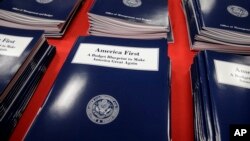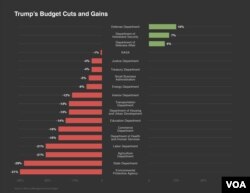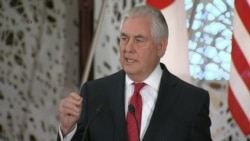The White House has unveiled what it is a calling an “America First” budget for the federal government that would significantly boost defense spending and offset the increase with cuts in funding for, among other things, foreign aid and the agency responsible for enforcing environmental regulations.
Thursday in a letter to Congress, the president said the proposed budget is aimed at making "safety of our people its number one priority - because without safety, there can be no prosperity."
The budget proposes a $54 billion increase in defense spending and cuts in non-defense programs, including congressional favorites such as medical research and help for homeless veterans. "We have tough choices that have been put off for too long," Trump wrote in the letter.
"There’s no question that this is a hard-power budget, it is not a soft-power budget," proclaimed Mick Mulvaney, the director of the Office of Management and Budget.
"That’s what our allies can expect, that’s what our adversaries can expect. That’s what the president wanted us to relay and I think we’ve done an effective job of that," Mulvaney told reporters at the White House Wednesday.
The first Trump budget, which covers the fiscal year beginning Oct. 1, features more money for defense, enforcing security at the border, and general law enforcement, as well as private and public school choice, according to Mulvaney.
The budget cuts – up to 28 percent in the case of the State Department -- will shrink the role of government and improve efficiencies, said Mulvaney.
Budget faces tough test in Congress
But legislative approval will require 60 votes in the Senate. The president’s party has a slim majority of 52 seats there, but there is no guarantee all Republicans will support the budget, and nearly all Democrats are likely to oppose it.
"These are categories of expenditures that form the backbone of the economy – education, the environment, foreign aid and infrastructure," the senior Democratic congressman on the House Budget Committee, John Yarmuth, told VOA News. "I think it's going to be very hard for Republican members to support some of these draconian cuts."
Some of the reductions, acknowledged the OMB director, are "fairly dramatic," including at the State Department. Asked if he sees a risk to deflating U.S. soft power (influencing other countries through culture, values and economic policies), the OMB director declined to give an assessment.
Mulvaney insists that although the State Department will see more than a quarter of its funds taken away, "we believe that we have protected the core diplomatic function of State."
Secretary of State Rex Tillerson reportedly protested even deeper cuts to his department’s budget.
But Tillerson has since expressed a willingness to accept the reductions that were eventually proposed, noting the "historically high level of budgetary resources" in the agency's current budget.
"The level of spending that the State Department has been undertaking in the past, and particularly in this past year, is simply not sustainable," Tillerson told reporters Thursday in Tokyo, Japan.
WATCH: Tillerson on budget cuts
The $3 billion of annual foreign aid to Israel will remain intact, according to administration sources.
READ MORE: State Depart. Braces for Steep Budget Cuts
As for the Environmental Protection Agency, Mulvaney said despite the proposed budget cut of more than 31 percent, its “core function” will not be endangered.
Federal worker unions protest
The head of the union representing 9,000 employees of the EPA disagrees, saying the proposed cut is “devastating to the point where it’s not going to be functional.”
John O’Grady, president of the executive board of Council 238 of the American Federation of Government Employees, said the EPA is "already on a starvation diet, with a bare bones budget and staffing level."
“Federal civilian employment is about the same number today as it was in 1962 under President John F. Kennedy,” O’Grady said, explaining it is the number of contracted workers, not staffers, which has swelled.
The overall attack by the administration on a supposedly bloated government work force is nonsense, adds O’Grady.
Thursday’s proposal only looks at discretionary spending. It does not address taxes and contains no revenue projections. It also excludes major programs such as Social Security, Medicaid and Medicare. It is designed as a blueprint for department and agency heads.
While much of the budget spotlight will be on the military getting a $54 billion boost, to a total just exceeding $600 billion, the Department of Homeland Security is to see a proposed six percent increase. But one high-profile DHS component, the Coast Guard, is expected to have its budget streamlined.
Mulvaney denied any entity is being targeted to provide equivalent funding for Trump’s frequently touted “wall” along the Mexican border. The 2017 supplemental budget will include $1.5 billion for the border structure and $2.6 billion in the 2018 budget. The combined $4.1 billion is significantly higher than earlier estimates of initial funding for the structure, but much lower than its estimated total cost of $22 billion.
Cuts also are being made to the Department of Housing and Urban Development to eliminate what White House officials call wasteful, duplicative programs.
Government money also is to be eliminated for the Corporation for Public Broadcasting, which distributes federal funds to 1,500 local non-commercial radio and television stations.
The White House intends to have a final budget finished by the first part of May.












